HYUNDAI NEXO 2022 Owners Manual
Manufacturer: HYUNDAI, Model Year: 2022, Model line: NEXO, Model: HYUNDAI NEXO 2022Pages: 561, PDF Size: 48.42 MB
Page 531 of 561
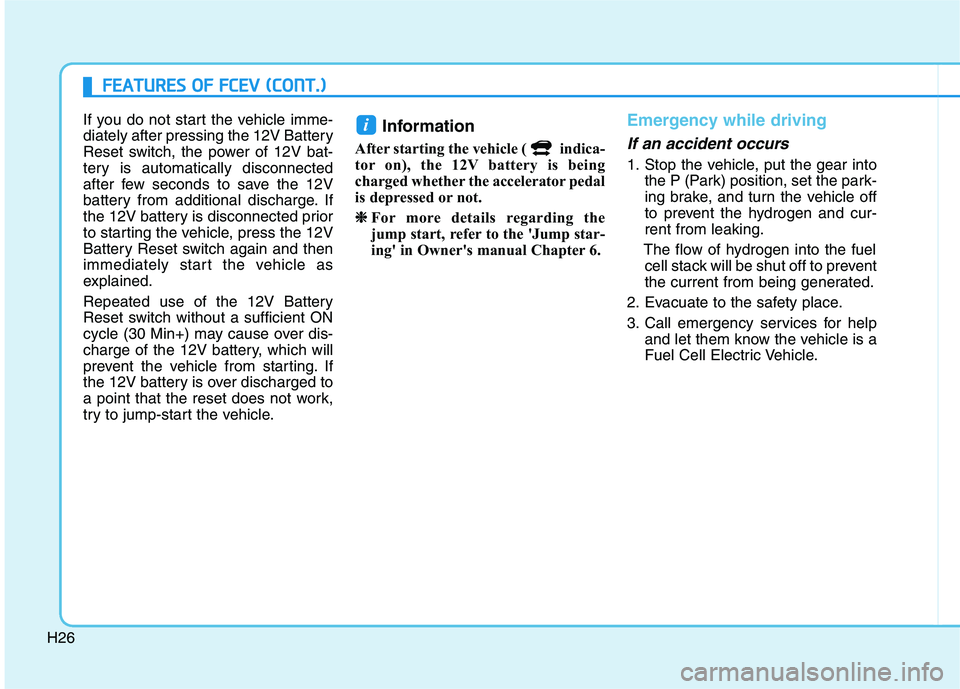
H26
F FE
EA
AT
TU
UR
RE
ES
S
O
OF
F
F
FC
CE
EV
V
(
(C
CO
ON
NT
T.
.)
)
If you do not start the vehicle imme-
diately after pressing the 12V Battery
Reset switch, the power of 12V bat-
tery is automatically disconnected
after few seconds to save the 12V
battery from additional discharge. If
the 12V battery is disconnected prior
to starting the vehicle, press the 12V
Battery Reset switch again and then
immediately start the vehicle as
explained.
Repeated use of the 12V Battery
Reset switch without a sufficient ON
cycle (30 Min+) may cause over dis-
charge of the 12V battery, which will
prevent the vehicle from starting. If
the 12V battery is over discharged to
a point that the reset does not work,
try to jump-start the vehicle.Information
After starting the vehicle ( indica-
tor on), the 12V battery is being
charged whether the accelerator pedal
is depressed or not.
❈ ❈
For more details regarding the
jump start, refer to the 'Jump star-
ing' in Owner's manual Chapter 6.
Emergency while driving
If an accident occurs
1. Stop the vehicle, put the gear into
the P (Park) position, set the park-
ing brake, and turn the vehicle off
to prevent the hydrogen and cur-
rent from leaking.
The flow of hydrogen into the fuel
cell stack will be shut off to prevent
the current from being generated.
2. Evacuate to the safety place.
3. Call emergency services for help
and let them know the vehicle is a
Fuel Cell Electric Vehicle.
i
Page 532 of 561
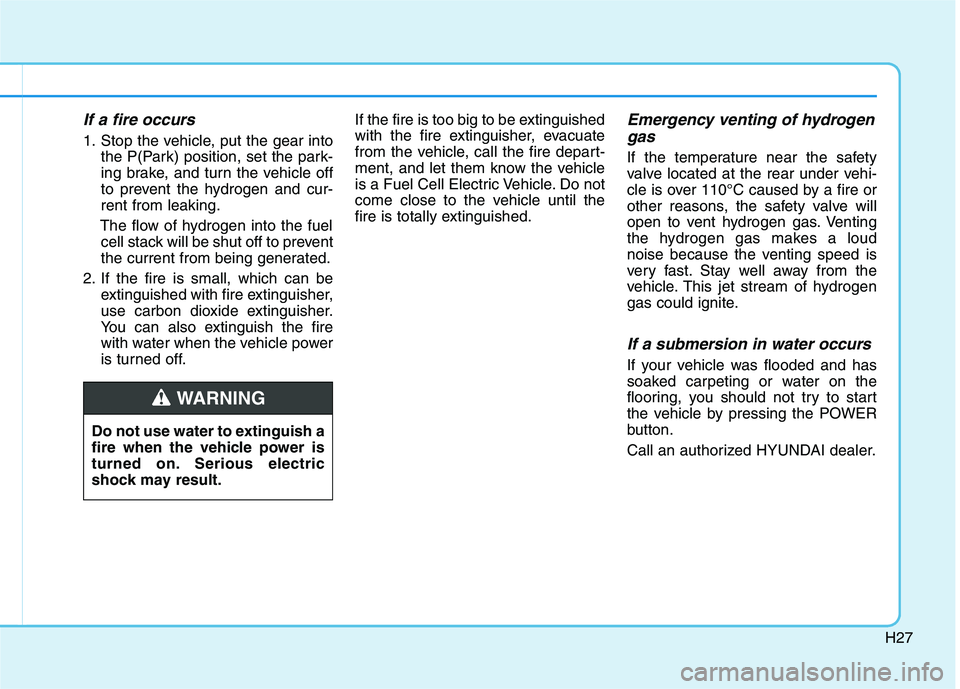
H27
If a fire occurs
1. Stop the vehicle, put the gear into
the P(Park) position, set the park-
ing brake, and turn the vehicle off
to prevent the hydrogen and cur-
rent from leaking.
The flow of hydrogen into the fuel
cell stack will be shut off to prevent
the current from being generated.
2. If the fire is small, which can be
extinguished with fire extinguisher,
use carbon dioxide extinguisher.
You can also extinguish the fire
with water when the vehicle power
is turned off.If the fire is too big to be extinguished
with the fire extinguisher, evacuate
from the vehicle, call the fire depart-
ment, and let them know the vehicle
is a Fuel Cell Electric Vehicle. Do not
come close to the vehicle until the
fire is totally extinguished.
Emergency venting of hydrogen
gas
If the temperature near the safety
valve located at the rear under vehi-
cle is over 110°C caused by a fire or
other reasons, the safety valve will
open to vent hydrogen gas. Venting
the hydrogen gas makes a loud
noise because the venting speed is
very fast. Stay well away from the
vehicle. This jet stream of hydrogen
gas could ignite.
If a submersion in water occurs
If your vehicle was flooded and has
soaked carpeting or water on the
flooring, you should not try to start
the vehicle by pressing the POWER
button.
Call an authorized HYUNDAI dealer. Do not use water to extinguish a
fire when the vehicle power is
turned on. Serious electric
shock may result.
WARNING
Page 533 of 561
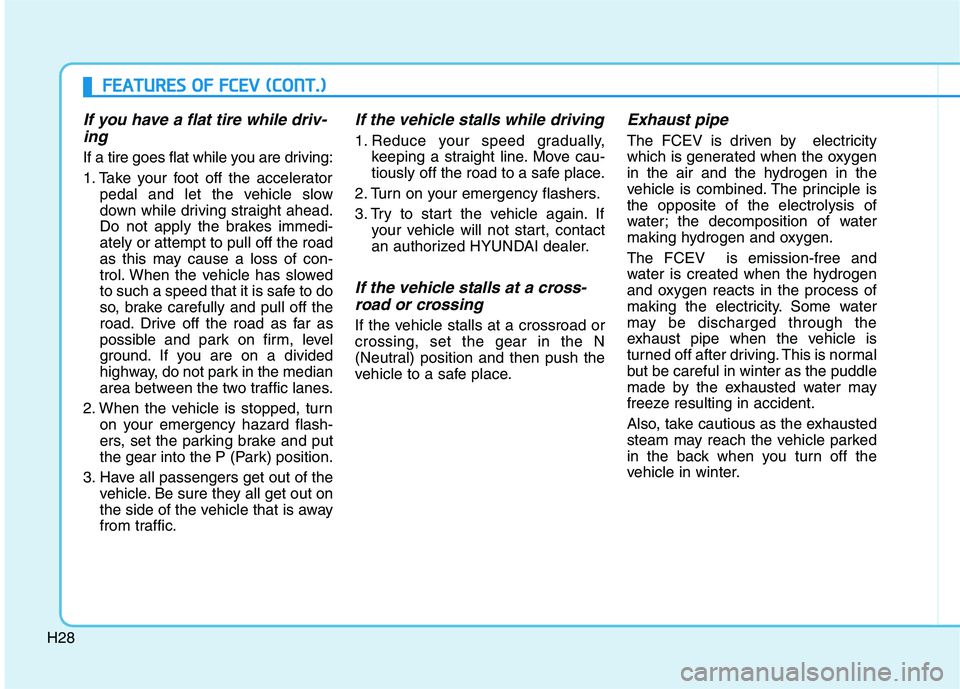
H28
F FE
EA
AT
TU
UR
RE
ES
S
O
OF
F
F
FC
CE
EV
V
(
(C
CO
ON
NT
T.
.)
)
If you have a flat tire while driv-
ing
If a tire goes flat while you are driving:
1. Take your foot off the accelerator
pedal and let the vehicle slow
down while driving straight ahead.
Do not apply the brakes immedi-
ately or attempt to pull off the road
as this may cause a loss of con-
trol. When the vehicle has slowed
to such a speed that it is safe to do
so, brake carefully and pull off the
road. Drive off the road as far as
possible and park on firm, level
ground. If you are on a divided
highway, do not park in the median
area between the two traffic lanes.
2. When the vehicle is stopped, turn
on your emergency hazard flash-
ers, set the parking brake and put
the gear into the P (Park) position.
3. Have all passengers get out of the
vehicle. Be sure they all get out on
the side of the vehicle that is away
from traffic.
If the vehicle stalls while driving
1. Reduce your speed gradually,
keeping a straight line. Move cau-
tiously off the road to a safe place.
2. Turn on your emergency flashers.
3. Try to start the vehicle again. If
your vehicle will not start, contact
an authorized HYUNDAI dealer.
If the vehicle stalls at a cross-
road or crossing
If the vehicle stalls at a crossroad or
crossing, set the gear in the N
(Neutral) position and then push the
vehicle to a safe place.
Exhaust pipe
The FCEV is driven by electricity
which is generated when the oxygen
in the air and the hydrogen in the
vehicle is combined. The principle is
the opposite of the electrolysis of
water; the decomposition of water
making hydrogen and oxygen.
The FCEV is emission-free and
water is created when the hydrogen
and oxygen reacts in the process of
making the electricity. Some water
may be discharged through the
exhaust pipe when the vehicle is
turned off after driving. This is normal
but be careful in winter as the puddle
made by the exhausted water may
freeze resulting in accident.
Also, take cautious as the exhausted
steam may reach the vehicle parked
in the back when you turn off the
vehicle in winter.
Page 534 of 561
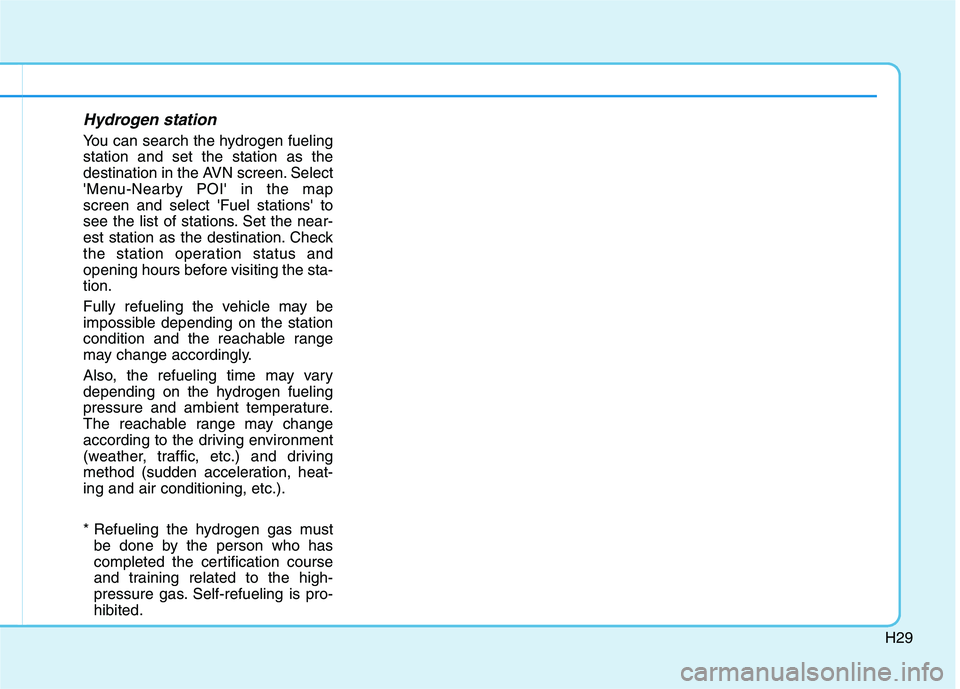
H29
Hydrogen station
You can search the hydrogen fueling
station and set the station as the
destination in the AVN screen. Select
'Menu-Nearby POI' in the map
screen and select 'Fuel stations' to
see the list of stations. Set the near-
est station as the destination. Check
the station operation status and
opening hours before visiting the sta-
tion.
Fully refueling the vehicle may be
impossible depending on the station
condition and the reachable range
may change accordingly.
Also, the refueling time may vary
depending on the hydrogen fueling
pressure and ambient temperature.
The reachable range may change
according to the driving environment
(weather, traffic, etc.) and driving
method (sudden acceleration, heat-
ing and air conditioning, etc.).
* Refueling the hydrogen gas must
be done by the person who has
completed the certification course
and training related to the high-
pressure gas. Self-refueling is pro-
hibited.
Page 535 of 561
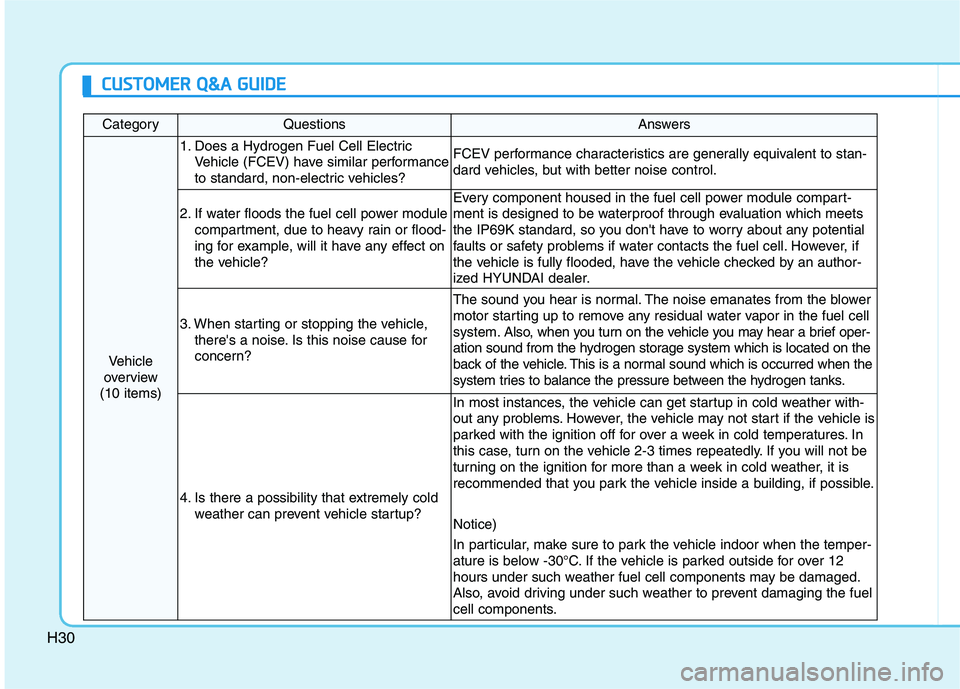
H30
C CU
US
ST
TO
OM
ME
ER
R
Q
Q&
&A
A
G
GU
UI
ID
DE
E
CategoryQuestionsAnswers
Vehicle
overview
(10 items)
1. Does a Hydrogen Fuel Cell Electric
Vehicle (FCEV) have similar performance
to standard, non-electric vehicles?FCEV performance characteristics are generally equivalent to stan-
dard vehicles, but with better noise control.
2. If water floods the fuel cell power module
compartment, due to heavy rain or flood-
ing for example, will it have any effect on
the vehicle?
Every component housed in the fuel cell power module compart-
ment is designed to be waterproof through evaluation which meets
the IP69K standard, so you don't have to worry about any potential
faults or safety problems if water contacts the fuel cell. However, if
the vehicle is fully flooded, have the vehicle checked by an author-
ized HYUNDAI dealer.
3. When starting or stopping the vehicle,
there's a noise. Is this noise cause for
concern?
The sound you hear is normal. The noise emanates from the blower
motor starting up to remove any residual water vapor in the fuel cell
system.Also, when you turn on the vehicle you may hear a brief oper-
ation sound from the hydrogen storage system which is located on the
back of the vehicle. This is a normal sound which is occurred when the
system tries to balance the pressure between the hydrogen tanks.
4. Is there a possibility that extremely cold
weather can prevent vehicle startup?
In most instances, the vehicle can get startup in cold weather with-
out any problems. However, the vehicle may not start if the vehicle is
parked with the ignition off for over a week in cold temperatures. In
this case, turn on the vehicle 2-3 times repeatedly. If you will not be
turning on the ignition for more than a week in cold weather, it is
recommended that you park the vehicle inside a building, if possible.
Notice)
In particular, make sure to park the vehicle indoor when the temper-
ature is below -30°C. If the vehicle is parked outside for over 12
hours under such weather fuel cell components may be damaged.
Also, avoid driving under such weather to prevent damaging the fuel
cell components.
Page 536 of 561
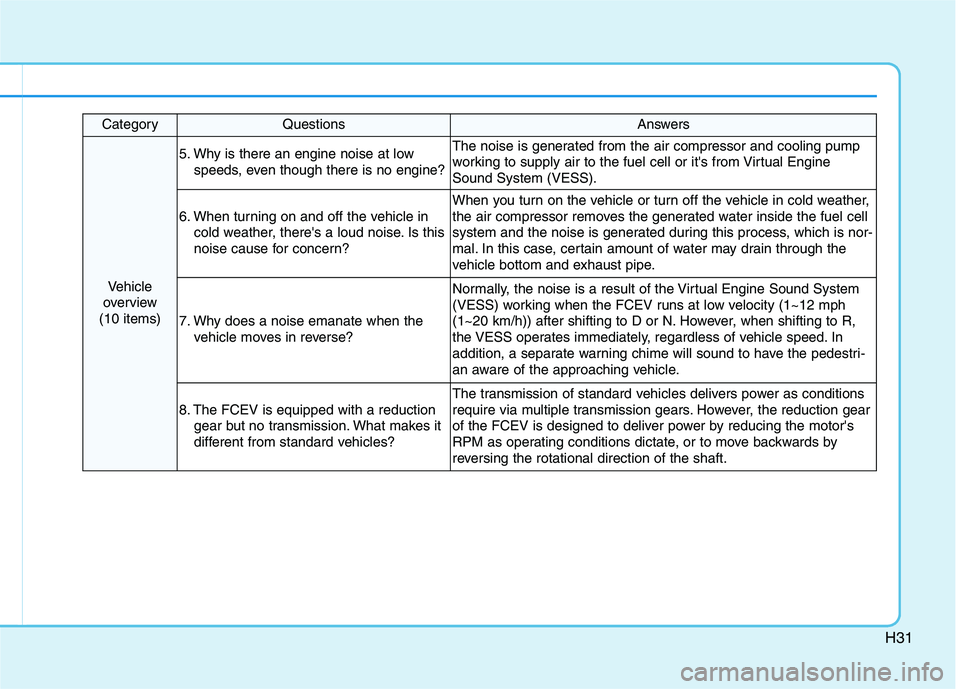
H31
CategoryQuestionsAnswers
Vehicle
overview
(10 items)
5. Why is there an engine noise at low
speeds, even though there is no engine?The noise is generated from the air compressor and cooling pump
working to supply air to the fuel cell or it's from Virtual Engine
Sound System (VESS).
6. When turning on and off the vehicle in
cold weather, there's a loud noise. Is this
noise cause for concern?
When you turn on the vehicle or turn off the vehicle in cold weather,
the air compressor removes the generated water inside the fuel cell
system and the noise is generated during this process, which is nor-
mal. In this case, certain amount of water may drain through the
vehicle bottom and exhaust pipe.
7. Why does a noise emanate when the
vehicle moves in reverse?
Normally, the noise is a result of the Virtual Engine Sound System
(VESS) working when the FCEV runs at low velocity (1~12 mph
(1~20 km/h)) after shifting to D or N. However, when shifting to R,
the VESS operates immediately, regardless of vehicle speed. In
addition, a separate warning chime will sound to have the pedestri-
an aware of the approaching vehicle.
8. The FCEV is equipped with a reduction
gear but no transmission. What makes it
different from standard vehicles?
The transmission of standard vehicles delivers power as conditions
require via multiple transmission gears. However, the reduction gear
of the FCEV is designed to deliver power by reducing the motor's
RPM as operating conditions dictate, or to move backwards by
reversing the rotational direction of the shaft.
Page 537 of 561
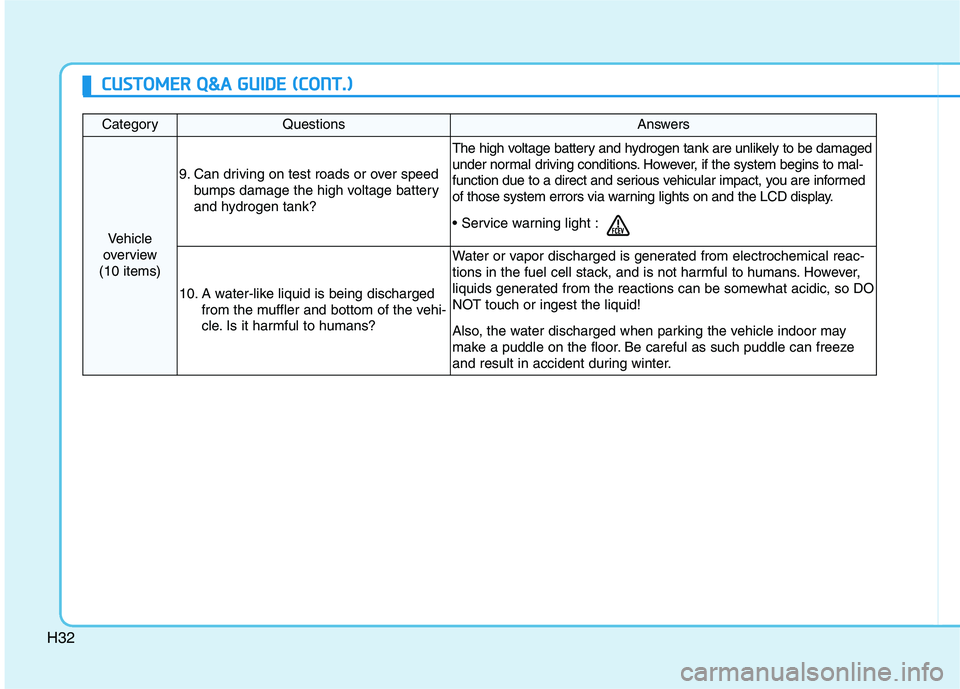
H32
CategoryQuestionsAnswers
Vehicle
overview
(10 items)
9. Can driving on test roads or over speed
bumps damage the high voltage battery
and hydrogen tank?
The high voltage battery and hydrogen tank are unlikely to be damaged
under normal driving conditions. However, if the system begins to mal-
function due to a direct and serious vehicular impact, you are informed
of those system errors via warning lights on and the LCD display.
10. A water-like liquid is being discharged
from the muffler and bottom of the vehi-
cle. Is it harmful to humans?
Water or vapor discharged is generated from electrochemical reac-
tions in the fuel cell stack, and is not harmful to humans. However,
liquids generated from the reactions can be somewhat acidic, so DO
NOT touch or ingest the liquid!
Also, the water discharged when parking the vehicle indoor may
make a puddle on the floor. Be careful as such puddle can freeze
and result in accident during winter.
C CU
US
ST
TO
OM
ME
ER
R
Q
Q&
&A
A
G
GU
UI
ID
DE
E
(
(C
CO
ON
NT
T.
.)
)
Page 538 of 561
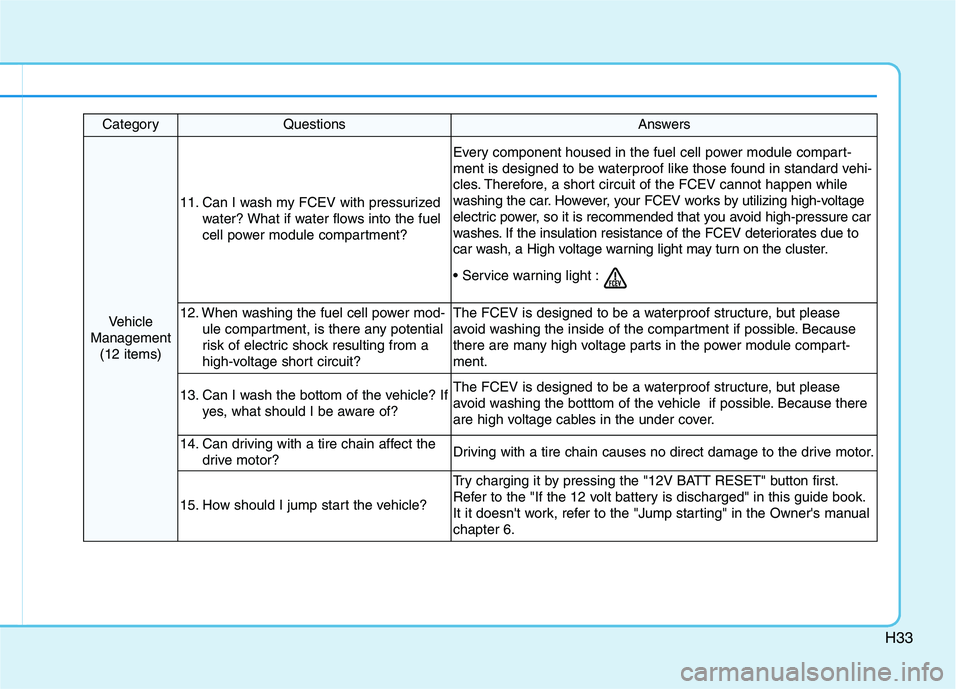
H33
CategoryQuestionsAnswers
Vehicle
Management
(12 items)
11. Can I wash my FCEV with pressurized
water? What if water flows into the fuel
cell power module compartment?
Every component housed in the fuel cell power module compart-
ment is designed to be waterproof like those found in standard vehi-
cles. Therefore, a short circuit of the FCEV cannot happen while
washing the car. However, your FCEV works by utilizing high-voltage
electric power, so it is recommended that you avoid high-pressure car
washes. If the insulation resistance of the FCEV deteriorates due to
car wash, a High voltage warning light may turn on the cluster.
12. When washing the fuel cell power mod-
ule compartment, is there any potential
risk of electric shock resulting from a
high-voltage short circuit?The FCEV is designed to be a waterproof structure, but please
avoid washing the inside of the compartment if possible. Because
there are many high voltage parts in the power module compart-
ment.
13. Can I wash the bottom of the vehicle? If
yes, what should I be aware of?The FCEV is designed to be a waterproof structure, but please
avoid washing the botttom of the vehicle if possible. Because there
are high voltage cables in the under cover.
14. Can driving with a tire chain affect the
drive motor?Driving with a tire chain causes no direct damage to the drive motor.
15. How should I jump start the vehicle?
Try charging it by pressing the "12V BATT RESET" button first.
Refer to the "If the 12 volt battery is discharged" in this guide book.
It it doesn't work, refer to the "Jump starting" in the Owner's manual
chapter 6.
Page 539 of 561
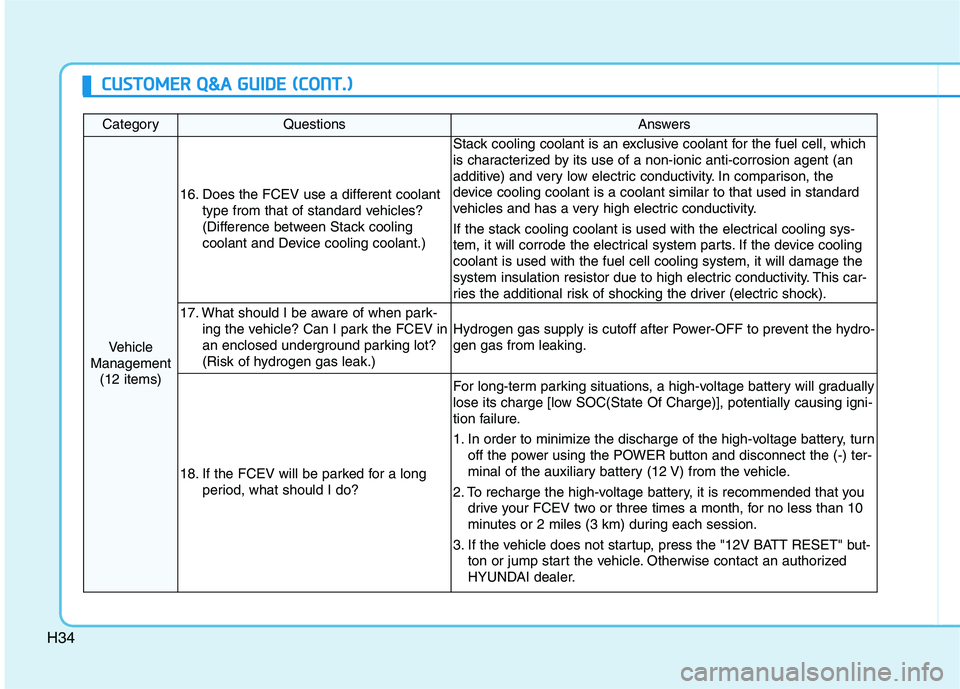
H34
CategoryQuestionsAnswers
Vehicle
Management
(12 items)
16. Does the FCEV use a different coolant
type from that of standard vehicles?
(Difference between Stack cooling
coolant and Device cooling coolant.)
Stack cooling coolant is an exclusive coolant for the fuel cell, which
is characterized by its use of a non-ionic anti-corrosion agent (an
additive) and very low electric conductivity. In comparison, the
device cooling coolant is a coolant similar to that used in standard
vehicles and has a very high electric conductivity.
If the stack cooling coolant is used with the electrical cooling sys-
tem, it will corrode the electrical system parts. If the device cooling
coolant is used with the fuel cell cooling system, it will damage the
system insulation resistor due to high electric conductivity. This car-
ries the additional risk of shocking the driver (electric shock).
17. What should I be aware of when park-
ing the vehicle? Can I park the FCEV in
an enclosed underground parking lot?
(Risk of hydrogen gas leak.)
Hydrogen gas supply is cutoff after Power-OFF to prevent the hydro-
gen gas from leaking.
18. If the FCEV will be parked for a long
period, what should I do?
For long-term parking situations, a high-voltage battery will gradually
lose its charge [low SOC(State Of Charge)], potentially causing igni-
tion failure.
1. In order to minimize the discharge of the high-voltage battery, turn
off the power using the POWER button and disconnect the (-) ter-
minal of the auxiliary battery (12 V) from the vehicle.
2. To recharge the high-voltage battery, it is recommended that you
drive your FCEV two or three times a month, for no less than 10
minutes or 2 miles (3 km) during each session.
3. If the vehicle does not startup, press the "12V BATT RESET" but-
ton or jump start the vehicle. Otherwise contact an authorized
HYUNDAI dealer.
C CU
US
ST
TO
OM
ME
ER
R
Q
Q&
&A
A
G
GU
UI
ID
DE
E
(
(C
CO
ON
NT
T.
.)
)
Page 540 of 561
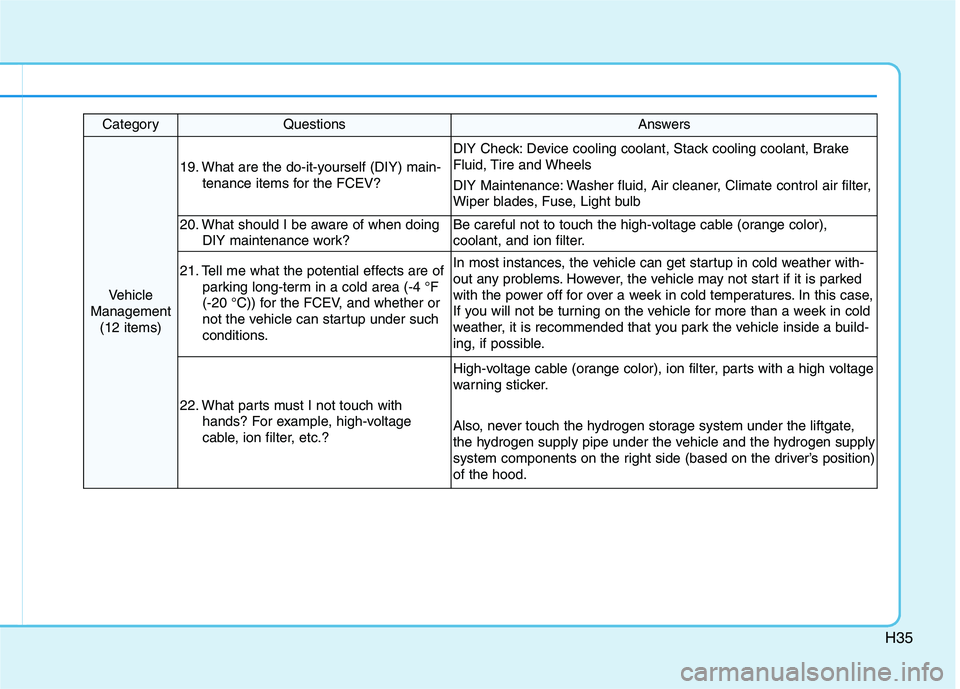
H35
CategoryQuestionsAnswers
Vehicle
Management
(12 items)
19. What are the do-it-yourself (DIY) main-
tenance items for the FCEV?
DIY Check: Device cooling coolant, Stack cooling coolant, Brake
Fluid, Tire and Wheels
DIY Maintenance: Washer fluid, Air cleaner, Climate control air filter,
Wiper blades, Fuse, Light bulb
20. What should I be aware of when doing
DIY maintenance work?Be careful not to touch the high-voltage cable (orange color),
coolant, and ion filter.
21. Tell me what the potential effects are of
parking long-term in a cold area (-4 °F
(-20 °C)) for the FCEV, and whether or
not the vehicle can startup under such
conditions.In most instances, the vehicle can get startup in cold weather with-
out any problems. However, the vehicle may not start if it is parked
with the power off for over a week in cold temperatures. In this case,
If you will not be turning on the vehicle for more than a week in cold
weather, it is recommended that you park the vehicle inside a build-
ing, if possible.
22. What parts must I not touch with
hands? For example, high-voltage
cable, ion filter, etc.?
High-voltage cable (orange color), ion filter, parts with a high voltage
warning sticker.
Also, never touch the hydrogen storage system under the liftgate,
the hydrogen supply pipe under the vehicle and the hydrogen supply
system components on the right side (based on the driver’s position)
of the hood.